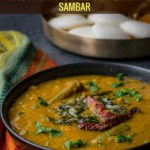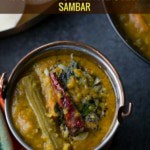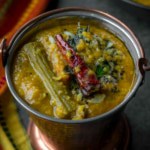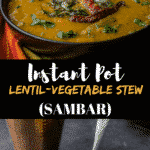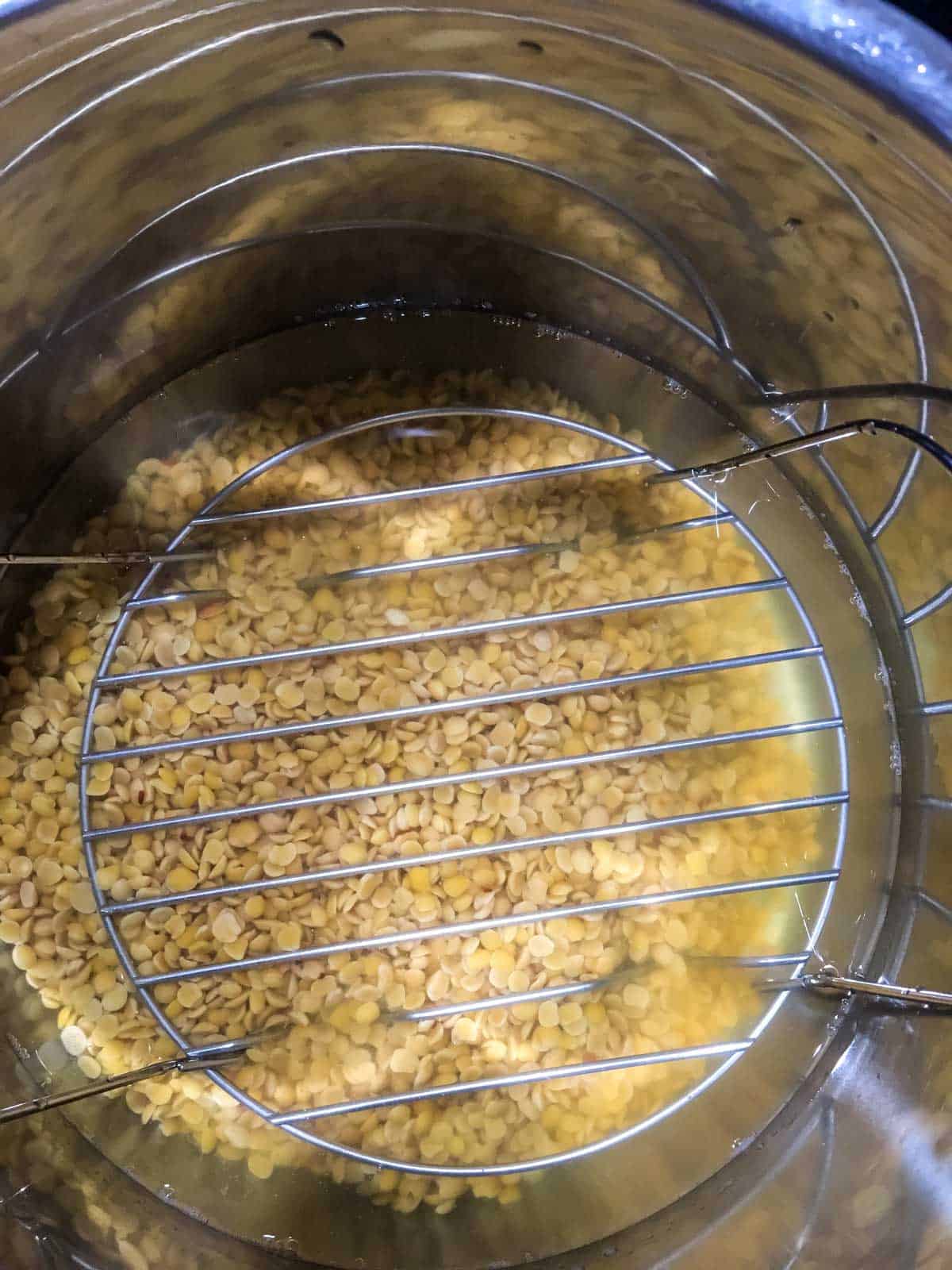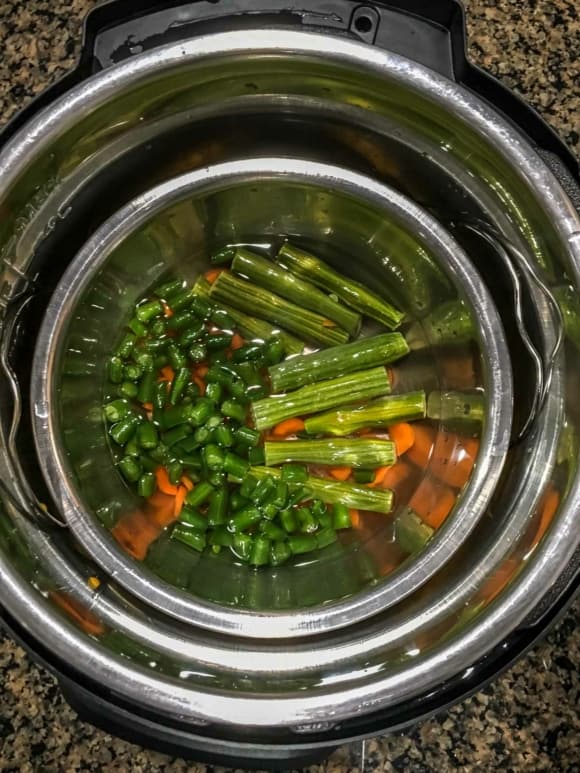Instant Pot Sambar (Lentil-vegetable stew)
Note: This post contains affiliate links. As an Amazon Associate I earn from qualifying purchases.
Sambar or Sambhar is a tangy and mildly spicy lentil-vegetable stew from the southern part of India. It is a staple in most South Indian homes and is served alongside idlis or dosas for breakfast or with rice for lunch/dinner.
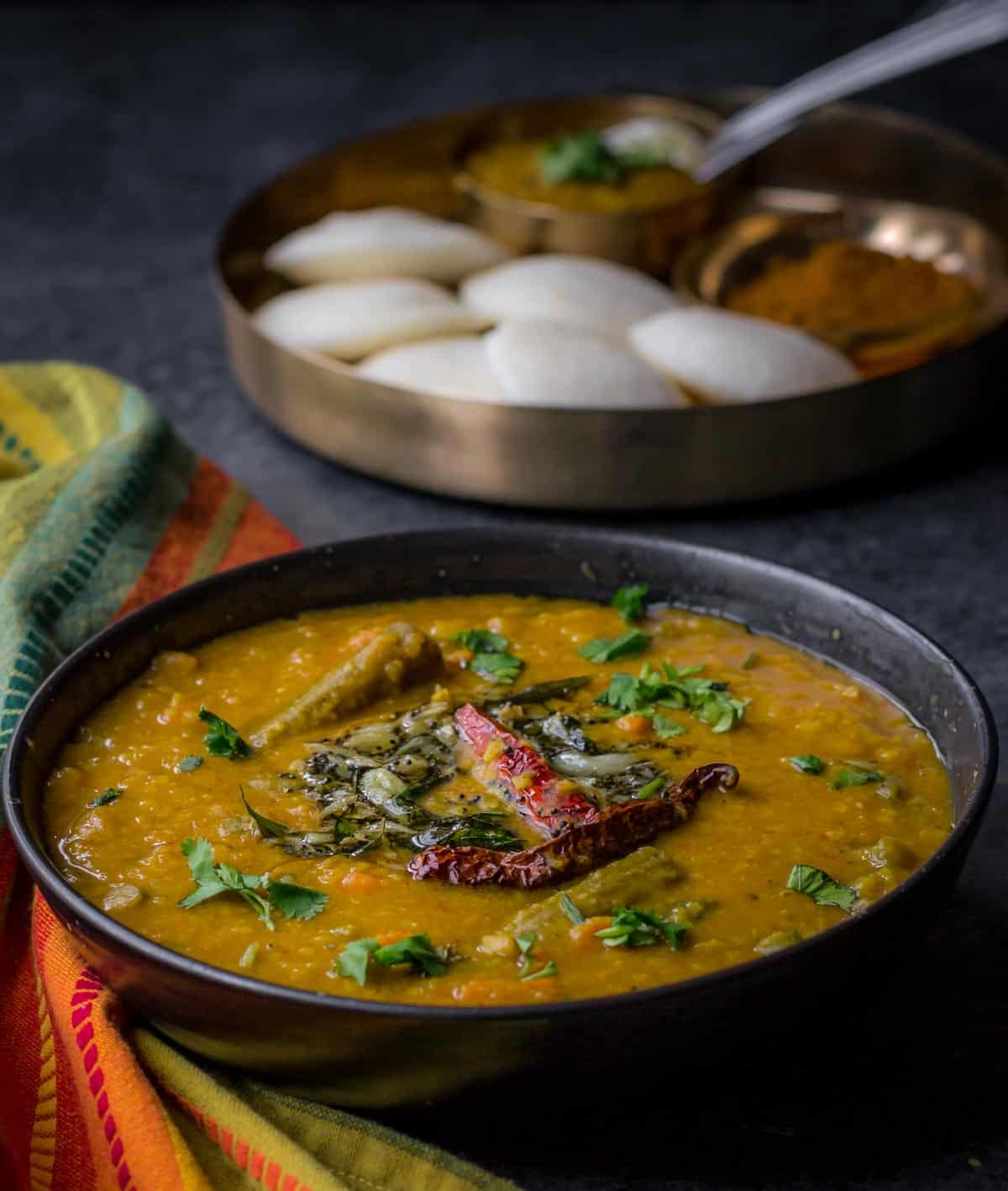
Here’s the thing with any sambar recipe including mine – the end result may be totally different from the sambar you’ve tasted in a restaurant or a friend’s home. This is because not only does every state in the southern part of India has its own way of cooking sambar, it is also because how the sambar tastes can vary depending on what vegetables you are using and if you have used store-bought sambar masala or made one at home.
Check out my recipe for homemade sambar powder.
Guidelines for making sambar
Information on the ingredients and what quantity to use –
- Split lentils – Tuvar or Toor dal (pigeon peas) is most commonly used. You could also do a ratio of 50:50 of Tuvar and Moong dal.
- Vegetables – You can use a variety of vegetables in sambar such as carrots, beans, drumsticks (moringa), spinach, okras, brinjal (eggplants), pumpkins, potatoes, shallots etc. I usually pick 2 or 3 vegetables that go together such as carrot, beans, drumsticks.
- Sambar powder – You can use either homemade sambar powder or store bought like MTR masala. The quantity of the sambar powder to be used depends on the aging of the sambar powder. Sambar powder like most spice blends loses its potency over time. As a rule of thumb, I use 1 tablespoon sambar powder for 1/2 cup of dal.
- Grated jaggery for a hint of sweetness. Start with a tablespoon, if you like it sweeter, you can always add it later.
- Tamarind for the tang. Increase/decrease the quantity based on the desired level of sweetness and tanginess. Note – I prefer to use seedless tamarind instead of the tamarind paste because the paste gives sambar a darker shade of brown and I like the orangish brown hue in sambar better.
- Finish off with tempering – Oil, mustard seeds, dried red chili (byadgi or Kashmiri), asafoetida (hing), garlic cloves and curry leaves (kadipatta). Note – both byadgi and Kashmiri are mild varieties of dried red chili.
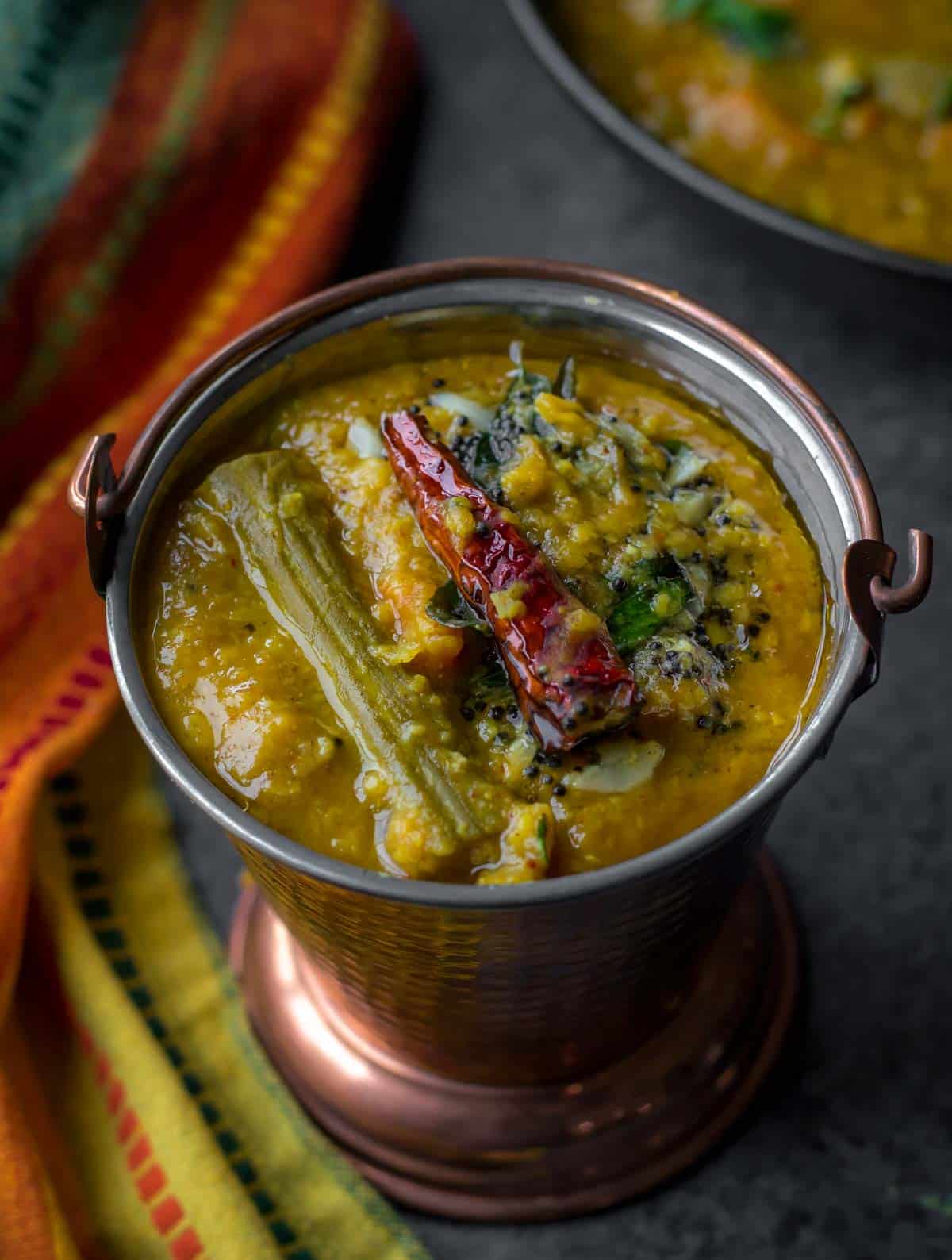
How to cook sambhar?
The easiest way is to dump all the ingredients (except the ones used for tempering) in a pressure cooker or Instant Pot and cook them together and then finish off with tempering. The sambar tastes great but the vegetables tend to get overcooked this way.
This method is perfect when you are in a rush but the if you prefer a bite in your veggies, then, cook the vegetables and dal separately. You can do that by using the PIP (pot-in-pot) method where you use stackable steel containers and place the dal in the lower one and vegetables in the steel bowl above.
Alternatively, add tuvar dal in the steel insert along with water and place the trivet on top like in the picture below. Place the steel bowl on top of the trivet.
|
|
|
How to make sambar for idli?
Sambar makes a perfect accompaniment to idlis, Ven Pongal and even plain rice.
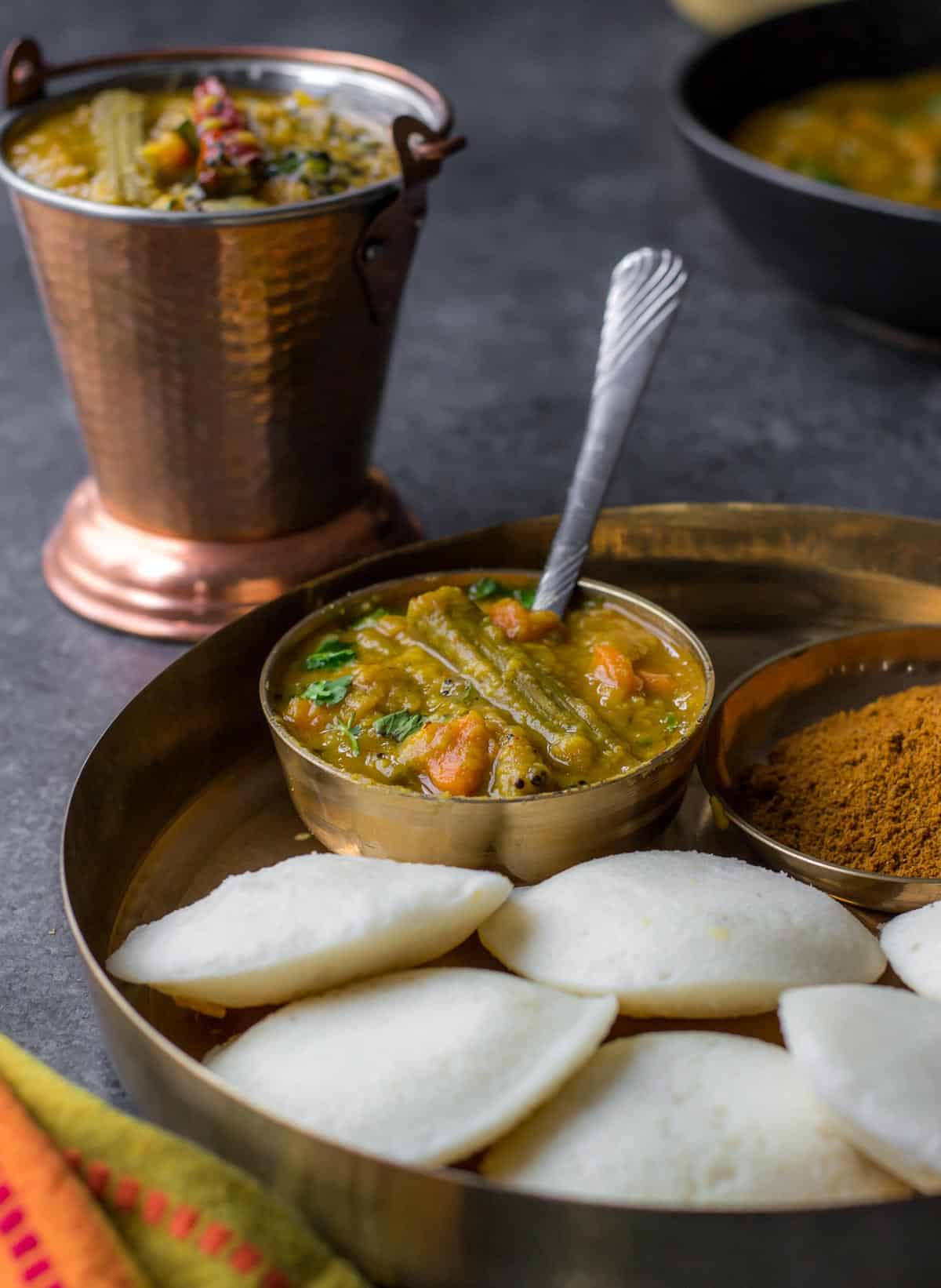
– Instant Pot pressure cooker review – Do you really need one?
– All you need to know about your Instant Pot
Other recipes for you to try on your Instant Pot
- Indian Chickpeas curry (Chole)
- Dal fry
- Kidney beans curry (Rajma)
- How to make yogurt in Instant Pot
- How to ferment Idli batter in Instant Pot

Sambar Recipe
Ingredients
To be pressure cooked
- 1 cup toor Dal / tuvar Dal toor dal, washed and rinsed
- ¼ cup chopped carrots
- ¼ cup chopped French green beans
- 2 15-inch Drumstick pods, raw Moringa, cut into 5-inch pieces
- ½ cup chopped onions
- ½ cup chopped tomatoes
- 3 cups water room temperature
Other Ingredients
- 2 tablespoons powdered jaggery adjust as needed
- 2- 3 tablespoons sambar powder homemade or MTR brand (adjust as needed)
- ½ tablespoon tamarind paste or fresh tamarind size of a small lime [see note]
- 1 teaspoon chili powder as needed
- salt as needed
- 1 teaspoon turmeric powder
Tempering Ingredients
- 1 tablespoon coconut oil
- 1 teaspoon mustard seeds rai
- 1-2 byadgi chili optional
- 1 sprig of curry leaves or kadipatta kadipatta
- 4 garlic cloves minced
- a pinch of asafoetida hing
Instructions
Using a stove top pressure cooker
- Pressure cook the dal, along with the veggies (carrots, beans, drumsticks, onions, and tomatoes) on medium heat with 3 cups of water (cook till the vent goes off 4 times and the dal is well cooked.) Shut the gas off and set aside.
- Add grated jaggery, turmeric powder, salt, chili powder, tamarind paste and sambar powder to a small bowl. Add 1/4 cup water and mix well.
- Once the pressure cooker has cooled down, open the lid and add the tamarind-sambar powder mixture and set it to boil over medium heat. Add a cup of water (or as needed) to get the sambar to a consistency you like.
- Do a taste test and add jaggery, sambar powder, chili powder as needed. [Always mix sambar powder with water on the side before adding it to Sambar, otherwise, they don’t mix well with the dal and end up as lumps]
- Heat oil in a separate pan and add mustard seeds and when they start to sputter, add red chilies and minced garlic cloves. Fry for around 10-20 seconds and then add asafoetida (hing), curry leaves and let it fry for 10 seconds or so. Add this to the dal mixture in the cooker. Mix well and turn off the heat.
- Garnish it with coriander leaves before serving.
Using Instant Pot
- Add dal along with 3 cups of water in the steel insert of the Instant Pot. Place a trivet over it. Add all the veggies (carrots, beans, drumsticks, onions, and tomatoes to a small bowl along with a cup of water. Place it on the trivet.
- Select “Pressure Cook.” Adjust the time to 15 minutes and set the pressure selection to high. Cover the Instant Pot lid and lock it. Make sure the vent is at sealing position. This step takes about 45 minutes - around 15 minutes to build pressure,15 minutes to cook and 15 minutes for the vent to return to the venting position.
- Add grated jaggery, turmeric powder, salt, chili powder, tamarind paste and sambar powder to a small bowl. Add 1/4 cup water and mix well.
- When the Instant Pot vent returns to the venting position, press warm/cancel and open the Instant pot lid. Remove the steel bowl with veggies carefully (will be hot to touch) and transfer the contents - veggies along with the water into the steel insert with the dal.
- Press the Saute function. Press the Adjust button to move the selection to “medium”. Add the tamarind-sambar powder mixture (from step 4) to the dal and mix well. Let the mixture come to a boil.
- Add a cup of water (or as needed) to get the sambar to a consistency you like. Do a taste test and add jaggery, sambar powder, chili powder as needed. [Always mix sambar powder with water on the side before adding it to Sambar, otherwise, they don’t mix well with the dal and end up as lumps].
- Heat oil in a separate pan and add mustard seeds and when they start to sputter, add red chilies and minced garlic cloves. Fry for around 10-20 seconds and then add asafoetida(hing), curry leaves and let it fry for 10 seconds or so.
- Add this to the dal mixture in the Instant Pot. Mix well and turn off the heat by pressing the warm/cancel button.
- Garnish it with coriander leaves before serving.
Notes
- If using fresh tamarind, take chunks of tamarind from the package and roll into a ball. The ball should be approximately the size of a ping pong/golf ball or a small lemon (approximately 1.5 inches in diameter). Soak it in 1/2 cup hot water for about 10 minutes before use. You can also substitute fresh tamarind with 1/2 tablespoon tamarind paste or a tablespoon of lime juice.
- You can always use stackable containers in a stovetop pressure cooker as well. Place dal in the bottom bowl and vegetables on the top. Make sure to use a trivet and add water to the base before you do so. Follow the instructions in your pressure cooker manual.
- Always mix sambar powder with water on the side before adding it to hot sambar, otherwise, they don’t mix well with the dal and end up as lumps.
Disclaimer: Approximate nutritional information is provided as a courtesy and can vary depending on the exact ingredients/brands used. If you have health issues, please work with a registered dietician or nutritionist.
Nutrition
Affiliate Disclosure: I am grateful to be of service and bring you content free of charge. To do this, some of the links on this post are affiliate links, which means that I may earn a commission (at no cost to you) if you click on the link or make a purchase using the link. I only recommend products that I use and love myself, so I know you’ll be in good hands. Your support in purchasing through these links goes towards maintaining this website. Thank you!

